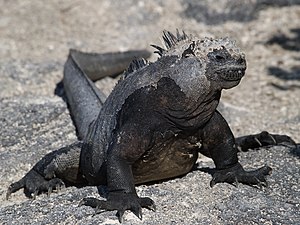Marine iguana
| Marine iguana | ||||||||||||
|---|---|---|---|---|---|---|---|---|---|---|---|---|

Marine iguanas ( Amblyrhynchus cristatus ) |
||||||||||||
| Systematics | ||||||||||||
|
||||||||||||
| Scientific name of the genus | ||||||||||||
| Amblyrhynchus | ||||||||||||
| Bell , 1825 | ||||||||||||
| Scientific name of the species | ||||||||||||
| Amblyrhynchus cristatus | ||||||||||||
| Bell , 1825 |
The marine iguana ( Amblyrhynchus cristatus ) is a species of iguana that is endemic to the Galápagos Islands . It lives on all islands, mostly on rocky coasts, but also in mangrove stands . Among the lizards living today, the marine iguana is the only species that looks for food in the sea.
The genetic diversity of the Galápagos marine iguanas throughout the Galápagos Archipelago was reclassified in 2017 after the discovery of five previously unknown subspecies and divided into eleven different subspecies. Among the species discovered is the Amblyrhynchus cristatus godzilla, which looks similar to the cinema monster Godzilla.
Appearance
The basic color of the marine iguanas is black. The reason for the dark tones is that the animals have to warm up quickly after their dives in the sea in order to be able to look for food in the sea again. They eat almost exclusively marine algae and kelp . The excess salt ingested with food is excreted through chloride cells in glands in the nostrils. Young animals have a light colored stripe on their back, and some adults are gray. The coloring of the males changes with the seasons. At the time of reproduction, they are most colorful on the southern islands, turning red and green. On Santa Cruz they are black and brick red, and on Fernandina they are brick red and dull green.
The different populations also differ in their size and color. The largest iguanas live on Fernandina and Isabela , the smallest live on Genovesa Island . Adult males are up to 1.3 meters long, while the females are only half as long at 60 centimeters. On San Cristóbal there are two populations that no longer reproduce with one another and thus behave like two different species, but continue to hybridize with marine iguanas from other islands .
Way of life
As cold-blooded animals, the marine iguanas can only spend a limited time looking for food in the cold sea. They dive for up to half an hour in shallow water to a depth of 15 meters and graze on algae. Then they have to warm up again in the sun. During the breeding season in December and January, the males become very territorial. They form territories in which they gather as many females as possible and defend them against other males.
The marine iguanas and the gruze head that live in the interior of the Galapagos Islands are said to have descended from a common ancestor who drifted from South America to the islands on tree trunks. The two lines separated about 4.5 million years ago.
Marine iguanas on Española ,
on Floreana
on Genovesa ,
on Santa Cruz
Danger
Young marine iguanas are eaten by feral domestic cats and dogs. Dogs can also prey on adult animals whose reflexes are restricted especially after a dive. The El Niño climatic phenomenon causes periodic decreases in population. The total number of animals is unknown, but according to the IUCN it is estimated to be 20,000 to over 40,000, and according to estimates by the Charles Darwin Research Station, hundreds of thousands of specimens.
Marine iguanas are fully protected by the laws of Ecuador and are listed in Appendix II of the Washington Convention on Endangered Species .
Individual evidence
- ↑ Godzilla marine iguanas discovered on the Galápagos Islands. Technical University of Braunschweig, May 10, 2017, accessed on May 10, 2017 .
- ^ A b Amy MacLeod, Ariel Rodríguez, Miguel Vences, Pablo Orozco-terWengel, Carolina García, Fritz Trillmich, Gabriele Gentile, Adalgisa Caccone, Galo Quezada, Sebastian Steinfartz: Hybridization masks speciation in the evolutionary history of the Galápagos marine iguana. Proceedings of the Royal Society B, June 2015, DOI: 10.1098 / rspb.2015.0425
- ↑ Amblyrhynchus cristatus in the endangered Red List species the IUCN 2006 Posted by: Nelson, K. Snell, H. & Wikelski, M., 2004. Retrieved on 16 September, 2006.
Web links
- Amblyrhynchus cristatus on the Animal Diversity Web
- Amblyrhynchus cristatus in The Reptile Database
- The dragon riddle - The missing marine iguanas of the Galapagos - A documentary by Thomas Behrend (2018). ARTE media library




